Table of Contents
If you’re looking for ways to boost your income without working harder, you might want to consider investing in dividend stocks, ETFs, and calls. These are assets that pay you a regular income just for holding them, regardless of how the market performs. In this article, I’ll show you seven of the best dividend stocks, ETFs, and calls to supercharge your wealth and generate passive income.
What are dividend stocks, ETFs, and calls?
Dividend stocks are shares of companies that pay out a portion of their earnings to shareholders on a regular basis. Dividend stocks are attractive because they provide a steady stream of income and also have the potential to appreciate in value over time.
ETFs, or exchange-traded funds, are collections of securities that track an index, sector, or theme. ETFs are convenient because they allow you to diversify your portfolio with one purchase and also have lower fees than mutual funds. Some ETFs also pay dividends to their investors.
Calls are options contracts that give you the right to buy a stock at a specified price within a certain period of time. Calls are risky but rewarding because they can amplify your returns if the stock price rises above the strike price. Some calls also pay dividends to their holders.
Why invest in dividend stocks, ETFs, and calls?
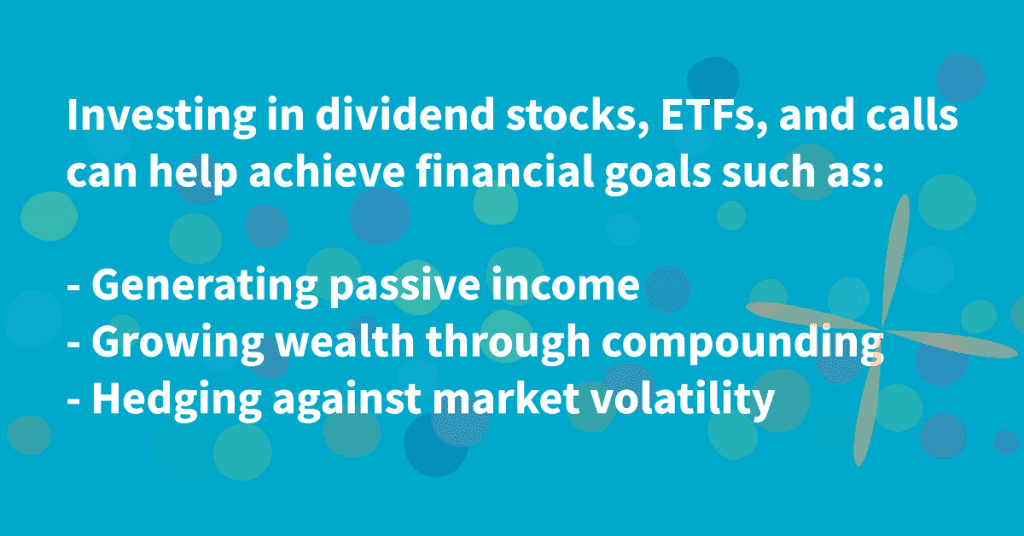
Investing in dividend stocks, ETFs, and calls can help you achieve several financial goals, such as:
- Generating passive income: Dividends and call premiums are cash payments that you receive without doing any work. You can use this income to supplement your salary, pay off debt, save for retirement, or spend on whatever you want.
- Growing your wealth: Dividends and call premiums can also be reinvested to buy more shares or options, which can increase your future income and capital gains. This is known as compounding, and it can help you grow your wealth exponentially over time.
- Hedging against market volatility: Dividends and call premiums can help you reduce your risk and cushion your losses during market downturns. Dividends tend to be more stable than stock prices, and calls can protect you from downside movements by limiting your losses to the premium paid.
Dividends and Calls: 7 Proven Ways to Turbocharge Your Earnings
How to choose the best dividend stocks, ETFs, and calls?
Not all dividend stocks, ETFs, and calls are created equal. Some may pay higher dividends or premiums than others, but they may also have lower growth prospects or higher risks. To choose the best dividend stocks, ETFs, and calls for your portfolio, you should consider several factors, such as:
- Yield: This is the annual dividend or premium divided by the share or option price. It tells you how much income you can expect to receive from an investment. A higher yield means a higher income, but it may also indicate a lower quality or a higher risk.
- Growth: This is the annual increase in the dividend or premium over time. It tells you how much your income can grow from an investment. A higher growth means a higher future income, but it may also reflect a lower current yield or a higher valuation.
- Safety: This is the ability of the company or fund to maintain or increase its dividend or premium over time. It tells you how reliable your income is from an investment. A higher safety means a lower probability of a dividend cut or a call expiration, but it may also imply a lower yield or a lower return potential.
7 Dividend Stocks, ETFs, and Calls for Passive Income
Based on these criteria, here are seven of the best dividend stocks, ETFs, and calls for passive income that you can invest in today:
1. Johnson & Johnson (JNJ)
Johnson & Johnson is a global healthcare giant that produces consumer products, pharmaceuticals, and medical devices. The company has been paying dividends for 59 consecutive years and has increased its dividend for 58 consecutive years. Its current yield is 2.5%, its five-year dividend growth rate is 6%, and its payout ratio is 46%. The company has a strong balance sheet, a diversified revenue stream, and a robust pipeline of new products. The company also has a call option with a strike price of $180 and an expiration date of January 21, 2022. The call option pays a premium of $3.40 per share and has a break-even price of $183.40.
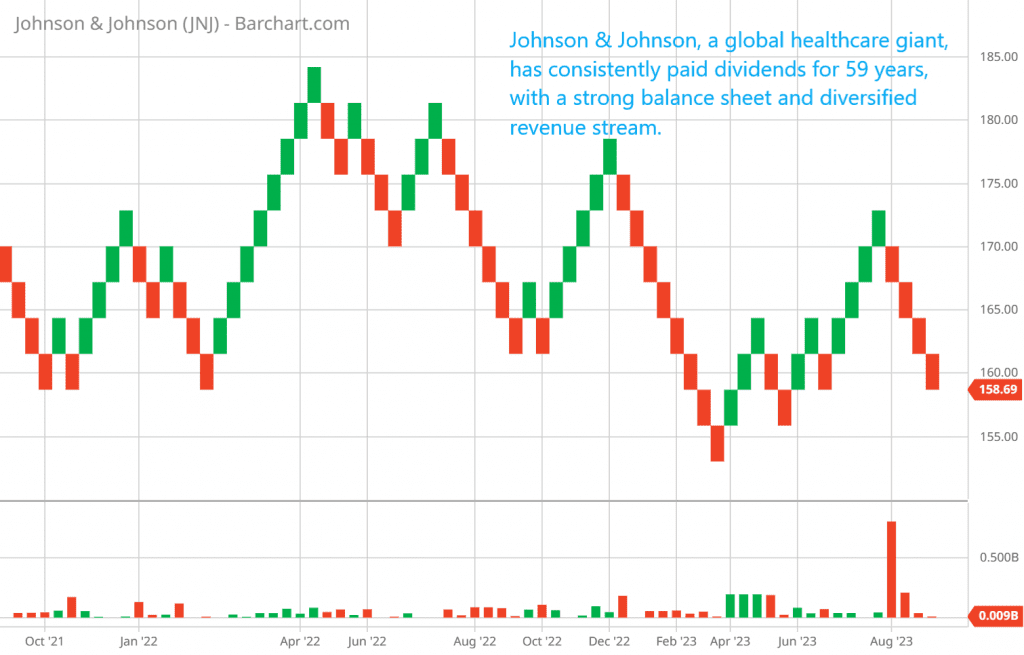
2. Vanguard High Dividend Yield ETF (VYM)
Vanguard High Dividend Yield ETF is an exchange-traded fund that tracks the performance of the FTSE High Dividend Yield Index, which consists of large-cap U.S. stocks that pay above-average dividends. The fund has a yield of 2.9%, a five-year dividend growth rate of 7%, and an expense ratio of 0.06%. The fund offers exposure to over 400 high-quality companies across various sectors and industries. The fund also has a call option with a strike price of $110 and an expiration date of January 21, 2022. The call option pays a premium of $1.60 per share and has a break-even price of $111.60.
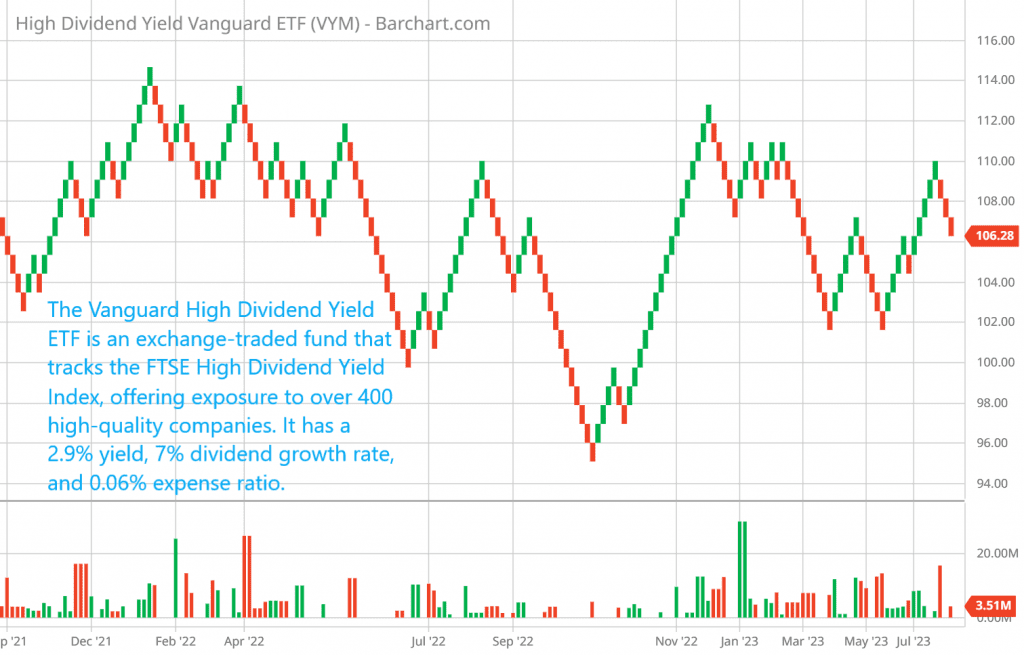
3. AT&T (T)
AT&T is a leading telecommunications and media company that provides wireless, broadband, video, and entertainment services. The company has been paying dividends for 37 consecutive years and has increased its dividend for 36 consecutive years. Its current yield is 7.4%, its five-year dividend growth rate is 2%, and its payout ratio is 58%. The company has a stable cash flow, a loyal customer base, and a strategic transformation plan to focus on its core businesses and reduce its debt. The company also has a call option with a strike price of $30 and an expiration date of January 21, 2022. The call option pays a premium of $0.70 per share and has a break-even price of $30.70.
4. SPDR S&P Dividend ETF (SDY)
SPDR S&P Dividend ETF is an exchange-traded fund that tracks the performance of the S&P High Yield Dividend Aristocrats Index, which consists of U.S. stocks that have increased their dividends for at least 20 consecutive years. The fund has a yield of 2.6%, a five-year dividend growth rate of 5%, and an expense ratio of 0.35%. The fund offers exposure to over 100 high-quality companies across various sectors and industries. The fund also has a call option with a strike price of $125 and an expiration date of January 21, 2022. The call option pays a premium of $1.90 per share and has a break-even price of $126.90.
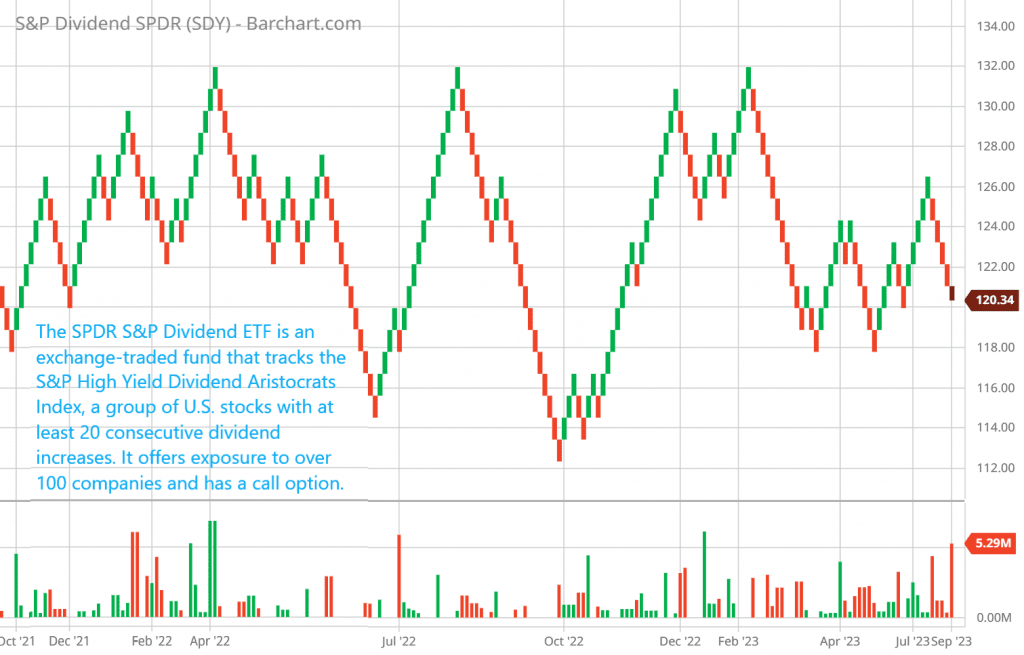
5. Chevron (CVX)
Chevron is one of the largest integrated oil and gas companies in the world, with operations in exploration, production, refining, marketing, and transportation. The company has been paying dividends for over 100 years and has increased its dividend for 33 consecutive years. Its current yield is 5%, its five-year dividend growth rate is 4%, and its payout ratio is 51%. The company has a strong balance sheet, a low-cost structure, and a disciplined capital allocation strategy. The company also has a call option with a strike price of $115 and an expiration date of January 21, 2022. The call option pays a premium of $2.80 per share and has a break-even price of $117.80.
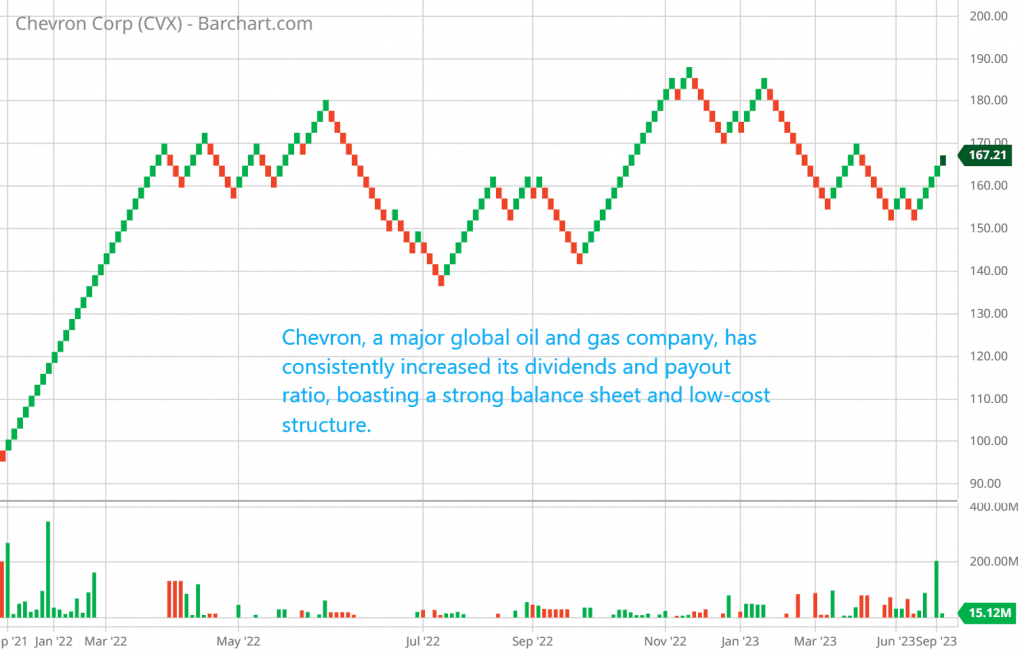
6. iShares Core Dividend Growth ETF (DGRO)
iShares Core Dividend Growth ETF is an exchange-traded fund that tracks the performance of the Morningstar US Dividend Growth Index, which consists of U.S. stocks that have a history of consistently growing their dividends. The fund has a yield of 1.8%, a five-year dividend growth rate of 10%, and an expense ratio of 0.08%. The fund offers exposure to over 400 high-quality companies across various sectors and industries. The fund also has a call option with a strike price of $55 and an expiration date of January 21, 2022. The call option pays a premium of $0.90 per share and has a break-even price of $55.90.
7. Home Depot (HD)
Home Depot is the largest home improvement retailer in the world, with over 2,200 stores in the U.S., Canada, and Mexico. The company has been paying dividends for 33 consecutive years and has increased its dividend for 12 consecutive years. Its current yield is 1.9%, its five-year dividend growth rate is 20%, and its payout ratio is 48%. The company has a strong competitive advantage, a loyal customer base, and an innovative digital strategy. The company also has a call option with a strike price of $350 and an expiration date of January 21, 2022. The call option pays a premium of $9 per share and has a break-even price of $359.
Leveraging Covered Calls for Enhanced Income
Covered calls can be a powerful strategy to turbocharge your income from dividend stocks and ETFs. Let’s explore how you can implement this strategy for each of the seven assets we’ve discussed.
Johnson & Johnson (JNJ)
Imagine you own 100 shares of Johnson & Johnson (JNJ) at its current price of $175 per share. To enhance your income, you can sell covered calls. Let’s say you sell one call option with a strike price of $180 and an expiration date of January 21, 2022, for a premium of $3.40 per share.
Outcome 1: If JNJ’s price remains below $180 by the expiration date, you keep the premium ($3.40 x 100 shares = $340) as extra income. Plus, you still own your JNJ shares and can sell more covered calls in the future.
Outcome 2: If JNJ’s price rises above $180, the call buyer may choose to exercise the option and buy your shares at the strike price of $180. You would still earn the premium of $340, and you’d also profit from the capital gain on your shares.
Vanguard High Dividend Yield ETF (VYM)
Let’s consider Vanguard High Dividend Yield ETF (VYM). If you own 100 shares of VYM at $110 per share, you can use covered calls to boost your income. Sell one call option with a strike price of $115 and an expiration date of January 21, 2022, for a premium of $1.60 per share.
Outcome 1: If VYM remains below $115 by the expiration date, you retain the premium ($1.60 x 100 shares = $160) as additional income, and you still hold your VYM shares.
Outcome 2: If VYM’s price exceeds $115, the call option may be exercised. You’d collect the premium of $160 and potentially benefit from any capital appreciation on your VYM shares.
AT&T (T)
For AT&T (T), which currently has a high yield, you can further boost your income through covered calls. Let’s assume you own 100 shares of T at $28 per share. You decide to sell one call option with a strike price of $30 and an expiration date of January 21, 2022, for a premium of $0.70 per share.
Outcome 1: If T’s price remains below $30 until the expiration date, you receive the premium ($0.70 x 100 shares = $70) as extra income. Your T shares remain in your portfolio.
Outcome 2: Should T’s price rise above $30, the call option could be exercised. You’d keep the premium of $70 and potentially benefit from the capital gain on your T shares.
SPDR S&P Dividend ETF (SDY)
Even with an ETF like SPDR S&P Dividend ETF (SDY), you can implement covered calls. Suppose you own 100 shares of SDY at $120 per share. Sell one call option with a strike price of $125 and an expiration date of January 21, 2022, for a premium of $1.90 per share.
Outcome 1: If SDY remains below $125 by the expiration date, you retain the premium ($1.90 x 100 shares = $190) as additional income, and your SDY shares remain intact.
Outcome 2: If SDY’s price surpasses $125, the call option might be exercised. You’d collect the premium of $190 and potentially benefit from any capital appreciation on your SDY shares.
Chevron (CVX)
For Chevron (CVX), a major player in the energy sector, you can utilize covered calls to enhance your income. Imagine you own 100 shares of CVX at $112 per share. Sell one call option with a strike price of $115 and an expiration date of January 21, 2022, for a premium of $2.80 per share.
Outcome 1: If CVX remains below $115 until the expiration date, you receive the premium ($2.80 x 100 shares = $280) as additional income, and your CVX shares remain in your portfolio.
Outcome 2: If CVX’s price exceeds $115, the call option could be exercised. You’d keep the premium of $280 and potentially profit from the capital gain on your CVX shares.
iShares Core Dividend Growth ETF (DGRO)
Even with an ETF like iShares Core Dividend Growth ETF (DGRO), you can engage in covered calls to bolster your income. Suppose you own 100 shares of DGRO at $54 per share. Sell one call option with a strike price of $55 and an expiration date of January 21, 2022, for a premium of $0.90 per share.
Outcome 1: If DGRO remains below $55 by the expiration date, you retain the premium ($0.90 x 100 shares = $90) as additional income, and your DGRO shares remain in your portfolio.
Outcome 2: If DGRO’s price goes above $55, the call option might be exercised. You’d collect the premium of $90 and potentially benefit from any capital appreciation on your DGRO shares.
Home Depot (HD)
Finally, consider Home Depot (HD), the world’s largest home improvement retailer. If you own 100 shares of HD at $345 per share, you can employ covered calls to boost your income. Sell one call option with a strike price of $350 and an expiration date of January 21, 2022, for a premium of $9 per share.
Outcome 1: If HD remains below $350 by the expiration date, you receive the premium ($9 x 100 shares = $900) as additional income, and your HD shares remain in your portfolio.
Outcome 2: If HD’s price exceeds $350, the call option might be exercised. You’d keep the premium of $900 and potentially profit from the capital gain on your HD shares.
By strategically implementing covered calls on these dividend stocks and ETFs, you can significantly enhance your income and make your investment portfolio work harder for you. However, it’s crucial to understand the associated risks and consider your investment goals before using this strategy. Always consult with a financial advisor for personalized guidance.
Conclusion: Empower Your Financial Future
As we conclude our journey through the world of dividend stocks, ETFs, and covered calls, it’s essential to recognize the immense potential these investment tools hold for your financial well-being. Your path to prosperity is now illuminated, and it’s time to seize the opportunities that await you.
Before diving headlong into these investment avenues, take a moment to reflect on your unique financial aspirations, risk tolerance, and investment horizon. Remember that successful investing is not a one-size-fits-all endeavor. It’s about crafting a personalized strategy that aligns with your goals.
Building a robust and diversified portfolio, blending income-generating assets like dividend stocks and ETFs with the strategic use of covered calls, can be your ticket to a more secure and prosperous future. The income you generate can be a lifeline, supplementing your salary, easing your financial burdens, or allowing you to pursue your dreams with greater freedom.
But knowledge is your greatest asset. Continue to educate yourself, stay informed about market trends, and be vigilant in your investment decisions. Explore more ways to maximize your wealth through passive income, as the financial landscape is ever-evolving, offering new opportunities for those who seek them.
Your financial future is in your hands, and with the right knowledge and strategy, you have the power to shape it according to your dreams and goals. So, take charge, embark on this exciting journey, and watch your wealth grow steadily and securely. Stay tuned for more insights and guidance as we continue to explore the vast universe of financial possibilities.
